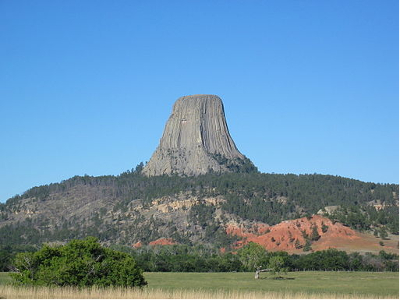Devil’s Tower is a geologic feature located in the Black Hills region of northeastern Wyoming. The mile-long monolith, which rises nearly 1,300 feet from the ground, is a prominent feature in the landscape. The many columns and cracks on its surface give the tower a striking appearance, and also make it a popular rock climbing destination.
Devils Tower was most likely formed underground when magma welled up into existing rock layers. The magma itself eventually cooled and hardened into rock. It contracted as it cooled, forming the hundreds of hexagonal vertical columns we see today. Whether the intrusion reached the surface when it originally formed is unclear. Over time, water and wind eroded the softer sedimentary layers around it, exposing the monolith.
 Other scientists theorize that Devil’s Tower is a volcanic plug of lava that hardened inside volcano. While the lack of volcanic ash and lava flows in the area make this scenario unlikely, it is possible that the volcanic material may also have eroded away.
Other scientists theorize that Devil’s Tower is a volcanic plug of lava that hardened inside volcano. While the lack of volcanic ash and lava flows in the area make this scenario unlikely, it is possible that the volcanic material may also have eroded away.
The site is sacred to the Lakota Sioux and many other Plains Indian tribes. Native American names for the monument include Bear's Tipi, Grizzly Bear's Lodge, Bear Lodge Butte, and Tree Rock. There are several Native American stories describing the origin of the tower. For example, according to the legend of the Kiowa tribe, the monument was created when bears began to chase a group of girls. The Great Spirit raised the ground beneath their feet, out of the animals’ reach. The bears clawed at the sides of the rock, while the girls were lifted into the sky to become the stars in the constellation Pleiades.
Devil’s Tower became the first national monument in the United States in 1906, under the orders of President Theodore Roosevelt. It is administered by the U.S. National Park Service. Hundreds of tourists visit the park each year, and dozens make the four to five-hour climb to the top.
Erosional forces continue to expose more of the monument. However, they are also eroding the tower itself at a slower rate. Eventually, the tower itself will be completely worn down and washed away.
Photo credit: Devil’s Tower by Kevstan (Own work) [CC BY-SA 3.0], via Wikimedia Commons